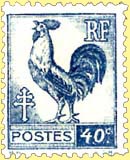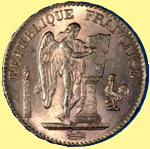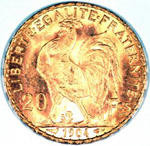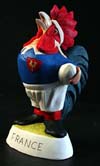Living in the Languedoc: Central Government: French National Symbols: The Cockerel (rooster)
  The
Cock (US Rooster), a Christian symbol of vigilance since the
New Testament story of the Passion, had long been part of
French national culture, largely because the Latin words for
cock and inhabitant of Gaul are similar (Gallus v gallicus). The
Cock (US Rooster), a Christian symbol of vigilance since the
New Testament story of the Passion, had long been part of
French national culture, largely because the Latin words for
cock and inhabitant of Gaul are similar (Gallus v gallicus).
In the Middle Ages it was widely depicted in French churches
and is recorded in 14th century Germany in references to France.
Chaucer's vain, foolish and boastful character Chantecleer
in the Canterbury Tales may have been recognised by his readership
as refering to the French national character  .
From the 16th century onwards representations of a cockerel
occasionally accompanied the King of France on coins - it
appears on the coins struck under both the Valois and Bourbon
kings. .
From the 16th century onwards representations of a cockerel
occasionally accompanied the King of France on coins - it
appears on the coins struck under both the Valois and Bourbon
kings.
    The
French Revolution gave wider currency to the emblem: it appeared
on the Seal of the Premier Consul, and surmounted the staff
carried by the allegorical figure of Fraternité.
It was an official emblem under the July Monarchy and the
Second Republic when it was used on the poles of regimental
flags. Napolean was not so keen it. When a commission
of Councillors of State proposed it as an emblem of France,
the Emperor rejected it on the grounds that: "the cockerel
has no strength; in no way can it stand as the image of an
empire such as France." He replaced it by a more appropriate
eagle. It returned to favour from 1830 onwards. Under
an an ordinance of July 30, 1830, the Gallic cock figured
on the buttons of the uniforms of the National Guard and surmounted
their colours. It replaced the fleur-de-lis as the national
emblem. In 1848 it featured on the the
Great Seal of France (The Official Seal of the French
Republic) - as it still does - depicted on a ship's rudder
next to the figure of Liberty. The
French Revolution gave wider currency to the emblem: it appeared
on the Seal of the Premier Consul, and surmounted the staff
carried by the allegorical figure of Fraternité.
It was an official emblem under the July Monarchy and the
Second Republic when it was used on the poles of regimental
flags. Napolean was not so keen it. When a commission
of Councillors of State proposed it as an emblem of France,
the Emperor rejected it on the grounds that: "the cockerel
has no strength; in no way can it stand as the image of an
empire such as France." He replaced it by a more appropriate
eagle. It returned to favour from 1830 onwards. Under
an an ordinance of July 30, 1830, the Gallic cock figured
on the buttons of the uniforms of the National Guard and surmounted
their colours. It replaced the fleur-de-lis as the national
emblem. In 1848 it featured on the the
Great Seal of France (The Official Seal of the French
Republic) - as it still does - depicted on a ship's rudder
next to the figure of Liberty.
   Napoleon
III viewed the cockerel with disfavour, but it virtually became
an official symbol of the Third Republic: the gates of the
Elysée Palace, erected at the end of the 19th century, feature
a cockerel. So did the 20 frank gold coin struck in
1898, and one appears more prominently on another 20 franc
coin minted in 1904. Napoleon
III viewed the cockerel with disfavour, but it virtually became
an official symbol of the Third Republic: the gates of the
Elysée Palace, erected at the end of the 19th century, feature
a cockerel. So did the 20 frank gold coin struck in
1898, and one appears more prominently on another 20 franc
coin minted in 1904.
    During
word war I, the French cockerel was often represented standing
in opposition to the German Imperial eagle. The cockerel
still features on the Seal of State, which dates back to the
Second Republic: a cockerel stands on the helm held by the
seated figure of Liberty. The Cockerel is now used mainly
in two specialised contexts: national sports teams and to
denote military valour (for example on memorials to those
who died in the Great War). During
word war I, the French cockerel was often represented standing
in opposition to the German Imperial eagle. The cockerel
still features on the Seal of State, which dates back to the
Second Republic: a cockerel stands on the helm held by the
seated figure of Liberty. The Cockerel is now used mainly
in two specialised contexts: national sports teams and to
denote military valour (for example on memorials to those
who died in the Great War).
The cockerel is one of the gererally recognised
symbols of sovereignty not mentioned in article
2 of the French Constitution of 1958, which refers only
to le drapeau tricolore, bleu, blanc, rouge: The
French Flag , L'hymne national, the national
anthem, The
Marseillaise and La devise de la République;
the motto . "Liberté,
Égalité, Fraternité".
For another take on the French Cockerel see Beyond
the French Riviera www.beyond.fr 
|
|
 The Phrygian Cap or Liberty Cap The Phrygian Cap or Liberty Cap
|

|
The Fasces 
|
|
|

